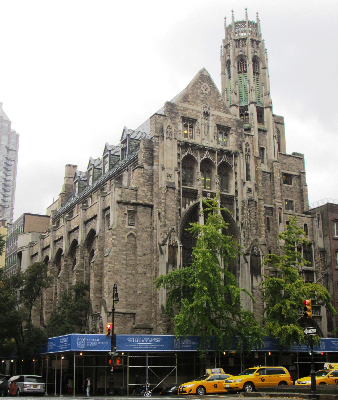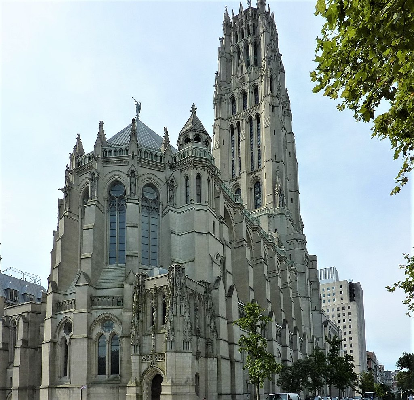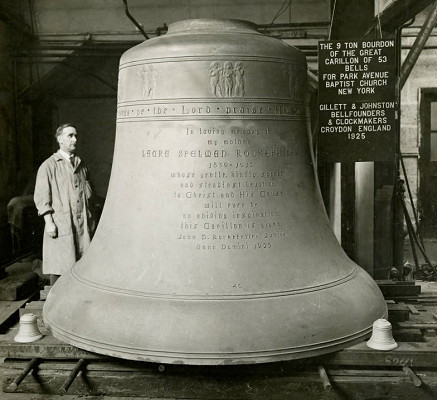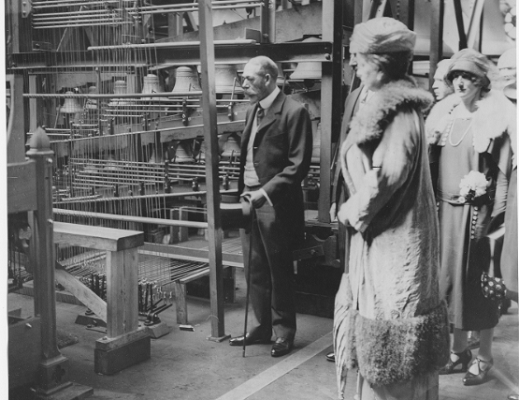

| Documentary History of American Carillons | Chronological List of Carillons in the United States | History of American Bell Foundries | Import Tariffs on Bells and Carillons |
 |
 |
| Park
Avenue Baptist Church |
Riverside Church |
 |
 |
 |
| 9-ton
bourdon bell for the Park Avenue Baptist Church |
Their majesties, King George V and Queen Mary, inspecting the world's largest carillon in the Gillett & Johnston foundry for the Park Avenue Baptist Church, May 12, 1925 |
20-ton bourdon bell for the Riverside Church |
| Links to Carillon Inventories | ||
| GCNA | Tower Bells | Bok Tower Gardens |
John D. Rockefeller, Jr. donated a 53-bell carillon to the Park Avenue Baptist Church on Park Avenue in New York City in honor of his mother Laura Spelman Rockefeller. The bells were cast by Gillett & Johnston of Croydon, England and were dedicated by Anton Brees on December 27, 1925. Brees did not have a long tenure working for the church, as he made demands including shutting down traffic on neighboring streets during his concerts and having a private bath. Despite this, Brees had a long and successful career as a carillonneur in the United States until his death in 1967
Rockefeller had undertaken substantial research before buying the carillon.
The relocated and enlarged carillon was played for the first time at Riverside Church on December 24, 1930 with recitals given by Kamiel Lefevere.
The carillon was enlarged in 1931 to 72 bells by Gillett and Johnston and two bells from the van Bergen Bell Foundry were added in 1956.
Tim Hurd renovated the carillon from 2000-2004 and 58 bells were recast or replaced by the Whitechapel Bell Foundry in London.
The Park Avenue church was bought by the Central Presbyterian Church, which installed a 50-bell electro-mechanical carillon in 2020.
References
1922 "Rockefeller
Gives 42 Bells To Park Ave. Baptist Church," The New York Times,
December 6, 1922, Page 1.
1925 "Carillon,"
The New Yorker 1(37):2-3 (October 31, 1925)
The Park Avenue Carillon represents an advance over previous chimes of
approximately similar size, for a special attachment of the clapper on
each bell makes it possible for the carilloneur to modulate tone
volume. Until now that was impossible. A note, however often
struck, always had the same value, and went on welling into the melody
until its last vibrations died off in the dim distance.
1925
"Carillon,"
Time, 6(14):22 (October 5, 1925)
Park Avenue Baptist Church Carillon. There is now tawdry
arrangement for electrical ringing.
1925
"Carillon,"
Time, 6(23):18 (December 7, 1925)
Rockefeller Jr. Keep children awake?
1925
"Carillon,"
Time, 6(25):18 (December 21, 1925)
August Hecksher offers to buy a carillon for the city of New York.
1926 "Reception to Anton Brees," The New Music Review 25(290):50-51 (January 1926)
1926 "Bells
and Oil," The New Yorker 2(31):17-18 (September 18, 1926)
If the fifty-three Rockefeller bells of the Park Avenue Baptist Church,
the largest of which weighs ten tons, peal a bit timidly into the great
chasm of Park Avenue just now, John D. Rockefeller, Jr., is not to
Blame. He did his best.
Last year Mr. Rockefeller imported from Belgium Anton Brees, gay young
carilloneur from the Cathedral of Antwerp. There was something
delightful about the artistic whole-heartedness with which the ringer of
bells in dreamy, mystic Flanders tackled the mighty city of New
York. His first request was that all traffic on Park Avenue be
stopped while he played his chimes.
Now, as everyone knows, there is nothing dreamy or impractical about the
church's trustees. They tend toward steel, oil, and pig iron.
A great city cannot stop its traffic on account of bells, even though they
be made of pig iron, they gently explained to Mr. Brees. Also, would
he please play things more familiar to Americans? Tinkling little
airs which ring from the cathedrals of Holland and Belgium mystified the
good people of New York.
Mr. Brees vowed he would not change his programs. Furthermore, he
declared he wanted a new apartment of private bath. He was tired of
living in the Y.M.C.A.
"A bath!" exclaimed the trustees of the Park Avenue Baptist Church.
In consternation they summoned Mr. Rockefeller. The latter was
pained. Wasn't Mr. Brees making five times what he made in Belgium?
Mr. Brees admitted that his was, then added, with Flemish shrewdness,
meeting the oil magnate on his own ground, "I've been told I should save
half my salary."
"Did you have a bath in Antwerp?" parried Mr. Rockefeller. And
scored too, for Anton Brees did not have one.
All morning they argued; then to his secretary's astonishment, Mr.
Rockefeller ordered lunch served them in his office. Following which
they argued all afternoon.
Now the Flemish bell-ringer has gone back to Antwerp, where cathedrals
boast Rubenses and baths are unknown. Percival Price,
twenty-one-year-old Canadian, has taken his place. The new artist's
music is as yet a bit timid, but this winter he is being sent abroad to
study under Josef Denyn, who for thirty-seven years has played the
incomparable seventeenth century Hemony bells which hang in the Cathedral
of Malines.
1926 "Baptists
Approve $4,000,000 Plans for Fosdick Church," The New York Times,
December 27, 1926 Page 1.
Tower to rise 375 feet. More bells for carillon.
1927 "Ruth
Muzzy Conniston Will Play Carillon," Decatur Herald and Review,
January 16, 1927, Page 20.
Ruth Muzzy Conniston will replace Percial Price at the carilloneur of the
Park Avenue Baptist Church in the recital to be broadcast by WJZ at 6:00
o'clock this evening. Percival Price, who has been heard in all of the
concerts of the past as the carilloneur of WJZ's broadcasts; is going
abroad to study at the Carillon school at Malines, Belgium, and will be
away during the months of January, February and March. Mrs. Conniston is a
student of Mr. Price on the carillon and a well known organist in New York
city. She will substitute for Mr. Price during his entire leave of
absence.
1930 "20-ton Bell Raised in Riverside Church," The New York Times, September 10, 1930, Page 27
1931 The
Riverside Church in the City of New York: A Handbook of the
Institution and Its Building
Pages 42-43: The Carillon
From this point the visitor must ascend on foot. He passes the
carillonneur’s studio on the twenty-first floor, the machinery and
equipment rooms on the twenty-second, and finds himself in the lower stage
of the belfry. He mounts the narrow stairs that take him up among the
bells to the observation platform, 380 feet above the ground. His
impressions here are likely to be unforgettable. Beneath him in three
directions stretches the metropolis with its lofty towers rising like a
dream to the south. On the west, shining in the light, the Hudson unfolds
its impressive vista for miles, bordered on the opposite bank by the lofty
Palisades. Beyond lies New Jersey, with its hills and meadows and
mountains. This is a different experience from looking out of the windows
of a tall office building. Apprehensively, perhaps, the visitor is
conscious of being surrounded here by 200,000 pounds of bell metal
suspended in mid-air. But there is no need to be apprehensive, for the
bells are supported firmly by some of the heaviest steel that has ever
been used in construction.
The entire mechanism of the carillon is so delicately adjusted that the
carillonneur, playing alone, is able to operate all of the seventy-two
bells from his clavier. It is a curious thought that this overpowering
mass of metal should be the bronze throat by which the "singing tower" may
lift its voice in song.
Originally the Laura Spelman Rockefeller Memorial Carillon consisted of 53
bells, installed in the building on Park Avenue. Nineteen new bells were
added when the church moved to Riverside Drive, making this carillon not
only the largest but the heaviest in the world. The bells range in weight
from the twenty-ton Bourdon, which is 123 inches in diameter, to a
ten-pound treble bell that is not much larger than an ordinary hand bell.
An inscription around the base of the Bourdon commemorates the fact that
“For the first time in history a carillon compass of five octaves is here
achieved and exceeded.” The Bourdon rests in a heavy steel frame on the
first stage of the belfry and swings by electric motors, as do the next
four largest bells. The other bells are stationary and are struck by
hammers operated by hand from the clavier, save for the largest of them.
So accurate is the balance of the large swinging bells that any one of
them may be set in motion by a push of the hand.
It is possible to play the carillon automatically, somewhat like a player
piano, but for delicacy of touch and expression the carillonneur must play
the bells manually from his cabin in the midst of them. Peals may be rung
on the five large bells and certain combinations may be played as chimes
from the organ console in the nave. Upon special occasions of mourning the
Bourdon tolls alone.
At certain times of the day the carillon plays the Parsifal Quarters,
arranged from the Holy Grail motif of Wagner’s opera, and the Bourdon
strikes the hours or quarters.
1939 The
Laura Spelman Rockefeller Memorial Carillon of the Riverside Church,
by Kamiel Lefevere and Grace H. Patton.
A brief history of its history structure and use.
1967 Anton Brees (14 Sep 1897 - 5 Mar 1967) grave in Lake Wales, Florida.
2004 "Carillon Riverside Church Rebuilt," by Timothy Hurd, World Carillon Federation
2008 England's
Child, The Carillon and the Casting of Big Bells, by Jill
Johnston
Pages 41-54: The Millionaire's Church
Pages 55-68: On to Riverside
© 2022 Morris A. Pierce